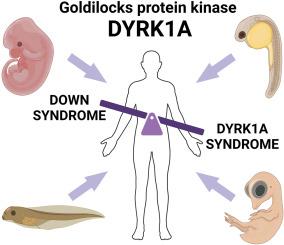The role of Goldilocks protein kinase DYRK1A in embryonic development
IF 2.1
3区 生物学
Q2 DEVELOPMENTAL BIOLOGY
引用次数: 0
Abstract
DYRK1A (Dual-specificity tyrosine-(Y)-phosphorylation regulated kinase 1A) is a dosage-sensitive gene whose expression must be tightly regulated to support normal development. This is supported by studies in animal models which demonstrate that both insufficient and excessive DYRK1A/Dyrk1a activity can impair development across multiple organ systems. In humans, both gain and loss-of-function alterations can disrupt the levels of DYRK1A, leading to structural birth defects and neurodevelopmental disorders. For example, DYRK1A haploinsufficiency causes DYRK1A syndrome, marked by intellectual disability and characteristic craniofacial features. DYRK1A is located on chromosome 21, and its overexpression in the context of trisomy 21 is believed to contribute to the developmental anomalies and comorbidities seen in Down syndrome. Notably, normalizing DYRK1A genetically or pharmacologically in Down syndrome mouse models can partially rescue phenotypes, underscoring its pathogenic role in this genetic condition. This review highlights the critical need to understand the effects of altering DYRK1A dosage during embryogenesis to inform therapeutic strategies for DYRK1A related disorders and Down syndrome associated birth defects.

金发蛋白激酶DYRK1A在胚胎发育中的作用。
DYRK1A(双特异性酪氨酸-(Y)-磷酸化调节激酶1A)是一种剂量敏感基因,其表达必须严格调节以支持正常发育。动物模型研究表明DYRK1A/ DYRK1A活性不足和过度都会损害多个器官系统的发育。在人类中,获得和丧失功能的改变都可以破坏DYRK1A的水平,导致结构性出生缺陷和神经发育障碍。例如,DYRK1A单倍不全导致DYRK1A综合征,以智力残疾和特征性颅面特征为标志。DYRK1A位于21号染色体上,其在21三体中的过度表达被认为是唐氏综合征中发育异常和合并症的原因。值得注意的是,在唐氏综合征小鼠模型中,DYRK1A基因或药理学正常化可以部分地挽救表型,强调其在这种遗传条件下的致病作用。这篇综述强调了了解在胚胎发生过程中改变DYRK1A剂量的影响的迫切需要,以告知DYRK1A相关疾病和唐氏综合征相关出生缺陷的治疗策略。
本文章由计算机程序翻译,如有差异,请以英文原文为准。
求助全文
约1分钟内获得全文
求助全文
来源期刊

Developmental biology
生物-发育生物学
CiteScore
5.30
自引率
3.70%
发文量
182
审稿时长
1.5 months
期刊介绍:
Developmental Biology (DB) publishes original research on mechanisms of development, differentiation, and growth in animals and plants at the molecular, cellular, genetic and evolutionary levels. Areas of particular emphasis include transcriptional control mechanisms, embryonic patterning, cell-cell interactions, growth factors and signal transduction, and regulatory hierarchies in developing plants and animals.
 求助内容:
求助内容: 应助结果提醒方式:
应助结果提醒方式:


